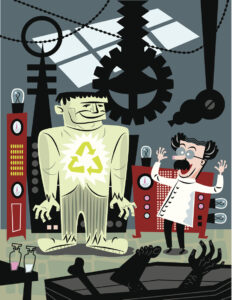Ever since I can remember, I have always been aware of something called the “Doomsday Clock,” a symbolized calculation produced by a panel of prominent scientists of just how close humanity is to destroying itself. Published on the cover of every issue of the Bulletin of the Atomic Scientists, a journal founded in 1945 by Manhattan Project physicists, the clock’s hands would move toward or away from the dreaded midnight hour depending on how near Armageddon was believed to be.
As a kid, the Doomsday Clock seemed an appropriate warning of how the conflict between the US and the Soviet Union might accidentally spin out of control. The famous Cuban Missile Crisis was just the most famous of many Cold War standoffs, and it was not unusual for magazines to run articles on how to build your own nuclear fallout shelter. The image of a grim device ticking down to the end of the world complemented popular films like Dr. Strangelove, Fail-Safe, and the original Planet of the Apes.
But as I grew older, it began to feel as though the Doomsday Clock was based more on left-wing politics than any kind of objective scientific measurement. For example, when the Soviets were rapidly building missiles in the late 1970s and candidate Ronald Reagan campaigned on building up US forces to match the threat, the clock was predictably moved forward. But Reagan got little credit for later using this military advantage to negotiate arms reductions with Russian President Mikhail Gorbachev.
The clock was once again set ahead when, after two years, the Trump administration had failed to make progress on an arms agreement with North Korea — even though Pyongyang did not test a single nuclear weapon during that period. Tellingly, no similar clock adjustment was made during the last year of the Obama administration, when North Korea tested two nuclear weapons and even bragged of having a hydrogen bomb.
Eventually I just stopped paying attention to the Doomsday Clock’s movements, which since 2009 have been represented digitally on the Bulletin’s website. It was not until last month, when it was revealed that the second hand was now just ninety seconds before midnight — closer than ever to presumed annihilation — that I took notice once again.
“Had Putin just used nuclear weapons on Kiev?” I wondered. “Was mainland China about to attack Taiwan? Had the CIA determined that North Korea’s Supreme Leader Kim Jong-un was about to bomb Japan?”
None of this.
It seems that during my skeptical disregard for the clock, I had missed the news that the Bulletin’s governing bodies, which in 1948 included Albert Einstein and J. Robert Oppenheimer, had subsequently added environmentalists, media consultants, Washington policy experts, and even an art museum curator. Neither was I aware that Jerry Brown, the former liberal governor of California, had been appointed the Bulletin’s executive chair.
It therefore did not occur to me that what had caused the Bulletin to move the Doomsday Clock to its most dire position ever was not just Russia’s continuing assault on the Ukraine, but the cumulative “effects of climate change.” Indeed, the worst thing about the war itself was that it had “hamstrung the world’s response to climate change.”
Unsurprisingly, what most observers made of this alert had a lot to do with their ideological leanings. While at least acknowledging that the Doomsday Clock’s threat assessments have become politically controversial in recent years, the New York Times predictably chose to treat its warning about the environment as a worthy news story.
The Wall Street Journal, on the other hand, responded with an editorial by a former member of the Bulletin’s Board of Sponsors, physicist Lawrence M. Krauss, who wrote that “it’s time to retire the clock.” He noted that the Bulletin’s founders had clearly intended the clock to measure only the dangers posed by advances in nuclear weaponry.
“More to the point,” Krauss added, “the threats the clock now purports to measure are different in kind. Nuclear weapons could end human civilization in a day. The generation of greenhouse gases associated with human industrial activity won’t.”
Some clock critics, such as Danielle Butcher Franz, executive vice president of the American Conservation Coalition, argue that no matter what one’s position on climate change, alarmist symbols are no way to address it. “Immobilizing people with anxiety and despair is not only deeply unproductive,” she wrote, “it actively holds us back.”
As for myself, I confess to sharing Franz’s concern about the clinical impact of overly dramatizing climate problems. According to Climate One, American therapists increasingly “report that their patients are exhibiting symptoms of what they call ‘climate anxiety’ — loss of sleep, changes in appetite, feelings of grief, anger and hopelessness.” And a 2021 study published in the Lancet medical journal found that 39 percent of older teenagers worldwide were reluctant to have children because of the environment’s uncertain future and the added carbon footprint of having kids.
If the Bulletin of the Atomic Scientists is determined to keep resetting its Doomsday Clock’s face, the least it could do is admit that its own name has long been misleading. Something like Bulletin of Progressive Professionals would be far more appropriate. It might not sound as scientifically impressive, but at least it would be honest.
As Krauss himself put it, “The Bulletin of Atomic Scientists can continue to play a useful role by focusing on providing accurate information on technology and science to be used as a basis for public policy. Or it could rename itself… acknowledge that it is an advocacy organization, and make the best case for its well-intentioned proposals.”





